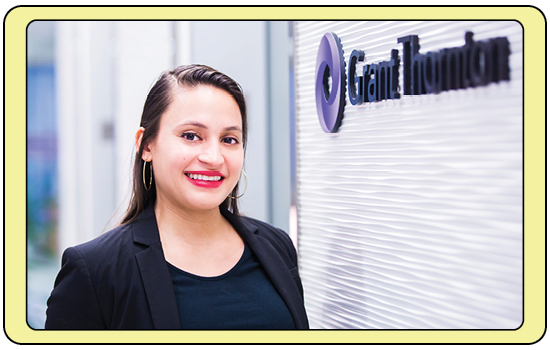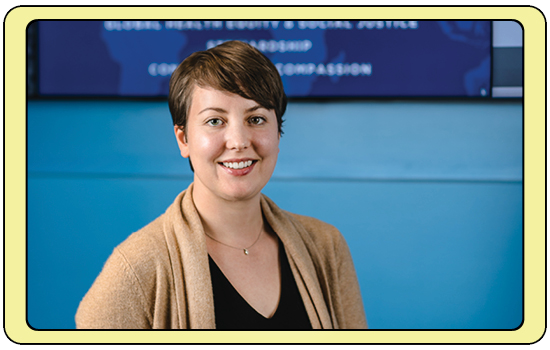REAL appeal
By Martha McKenzie

Illustration by Michael Sioan
Laura Salvatore Adams 16MPH applied—and was accepted—to several schools of public health when she decided to pursue an MPH. All had excellent reputations. All offered the health policy and management focus she desired. What tipped the balance in favor of Rollins was the Rollins Earn and Learn (REAL) program, which allowed her to work at Emory Healthcare implementing and analyzing a new software tool while she studied theory in the classroom.
“The REAL program was unique—the other schools not only didn’t offer anything like it, they actually discouraged students from working,” says Adams, who is manager of business applications for Grant Thornton. “I knew I needed to earn some money, but more than that, I needed real-world experience. Learning concepts in books is great but applying them in the field is where you really start to understand them.”
 The Rollins Earn and Learn program was the deciding factor for Laura Salvatore Adams 16MPH when she was selecting a graduate school.
The Rollins Earn and Learn program was the deciding factor for Laura Salvatore Adams 16MPH when she was selecting a graduate school.
That was exactly the intent when the REAL program was created 10 years ago. In 2009, work-study funding for graduate students was eliminated. Rollins’ Dean James W. Curran recognized the magnitude of the loss, so he oversaw the launch of REAL, a program in which the school and partner agencies and organizations split the cost of employing students. The students are able to earn needed funds, engage in hands-on research, and perform actual public health practice. Employers get to hire enthusiastic, committed students at a discount and to mentor the next generation of public health practitioners.
Today, half of all Rollins students receive a REAL award, which are given on a first-come, first-served basis. Some 5,300 students have worked through REAL since its inception, with a total of $22.4 million awarded. Employer partnerships have grown from nine to more than 150, including the Centers for Disease Control and Prevention; Children’s Healthcare of Atlanta; the American Cancer Society; CARE; federal, state, and county government agencies; and Rollins.
 REAL’s program leaders, l-r: Prudence Goss, assistant dean of admissions and student services; Catherine Strate, registration director; Heather Zesiger, senior director of student engagement; and Lisa Parker, REAL manager.
REAL’s program leaders, l-r: Prudence Goss, assistant dean of admissions and student services; Catherine Strate, registration director; Heather Zesiger, senior director of student engagement; and Lisa Parker, REAL manager.
“REAL is a signature program of our school,” says Heather Zesiger, senior director of student engagement. “It is definitely one of the things that sets us apart from other schools of public health, and both employers and students rate the program extremely high.”
Dr. Dayna Johnson was happy to discover the REAL program as a source of affordable research assistants when she joined Rollins as assistant professor of epidemiology in September 2018. “As a young investigator and new faculty member, grant funding is not plentiful,” she says. “Being able to hire students at a discounted rate to help with my sleep research has been invaluable. They collected data and built databases, and they did it at about a fifth of the cost I would have paid without the program.”
The American Cancer Society has been employing REAL students since the program began. Students have contributed in a variety of ways, from participating in operational aspects of research, to data analysis, to publishing studies. “Often the REAL students work on a project that we have been wanting to do but for which we haven’t had the manpower,” says Dr. Marji McCullough, senior scientific director of epidemiology research. “They provide critical help and contribute importantly to our mission.”
 Allison Snyder is now project manager of the Campaign Effectiveness program at the Task Force for Global Health. She considers contributions by REAL students invaluable.
Allison Snyder is now project manager of the Campaign Effectiveness program at the Task Force for Global Health. She considers contributions by REAL students invaluable.
Allison Snyder agrees. Until recently, she worked as a project support specialist at the Task Force for Global Health’s Neglected Tropical Disease (NTD) Support Center, and she points to the success she has had with her REAL student, Hasna Zainul 20MPH, as illustrative of the value of the program. During Zainul’s two-year stint at the Task Force, she has helped compile two compendiums of the 200-plus operational research studies the center manages, worked on quality control and development within an online project management tool, and boiled down a complex WHO manual on program monitoring guidelines into digestible videos.
“Hasna navigated everything beautifully,” says Snyder. “She had no background in video production, for example, but she taught herself through YouTube tutorials. She ended up taking big, complex 100-page PDFs and turning them into bite-sized three-to five-minute FAQ videos. So an NTD manager who does not have time to wade through a massive report can quickly and easily find the specific information they are looking for. As we have found with our other REAL students, Hasna has risen to the level of working at the same ability level as a full-time employee. The only difference is she works 20 hours a week instead of 40.”
For her part, Zainul counts her REAL experience among her most beneficial at Rollins. “You get to start implementing everything you are learning in the classroom from Day One,” she says. “That makes such a big difference. And perhaps just as important are the connections that working in a global health organization allow you to make in that field. Someone I knew from working at the Task Force connected me with a former colleague at the CDC, which resulted in a practicum in a completely different topic area that I also had an interest in. I’ve come to realize that everyone knows everyone else in the field of public health and that people are more than willing to make connections to help you succeed. Once you are able to break into that network, everything seems much more accessible.”
Like Zainul, REAL students eagerly sing the praises of the program. In addition to hands-on experience and connections, the work often fulfills applied practice experience (or practicum) requirements, leads to thesis topics, offers opportunities to publish papers, and always boosts the resume.
The financial benefit, however, cannot be ignored. Students can earn up to $5,000 a year through their REAL position, regardless of whether they are getting other financial aid. That money comes in very handy for students like Cassidy Whitson 20MPH.
“I came to Rollins directly from the Peace Corps, so I didn’t have a large bank account,” she says. “I was definitely looking for a school that offered financial aid. And since I didn’t have a hard science or public health background, I saw REAL as a great opportunity to gain that experience. I looked at several public health schools and did not see a program like this one anywhere else.”

5,328 Total number of students awarded 150+ Number of partner organizations outside of Emory $22,440,000 Total amount awarded Top 5 Partners• Emory University and affiliates (Emory Healthcare, The Carter Center, the Task Force for Global Health, Yerkes) 1,940 students • Centers for Disease Control and Prevention 1,253 students • CARE • American Cancer Society • Georgia Department of Public Health |
|---|
Her REAL experience with the CDC helped Whitson narrow her career focus. “I came to Rollins saying I loved everything—sexual and reproductive health, WASH [Water, Sanitation, and Hygiene], humanitarian emergencies,” she says. “ Over the course of highlighting work around World Water Day and World Toilet Day, I found that I most enjoy WASH work, and that’s where I’d like to focus my career.”
Just as helpfully, REAL can lead students to identify paths they do not want to go down. Shelby Rhee 18MPH came to Rollins convinced she wanted to work in health communications. After a year working on a CDC communications team on public health preparedness, she changed her mind. “I found communications to be more product-based than idea-based,” she says. “I was a bit surprised by that and didn’t find it a good match for me.”
For her second REAL year, she switched to the CDC’s public health ethics unit, a “fun consulting group within the agency that helps think through big ethical issues within the CDC,” says Rhee. “We looked athow the CDC implements policies and the strategies involved. I found that a much better fit, so I changed my career focus. I’m happy I had the opportunity to see that the communications path wasn’t right for me during my MPH rather than after I had graduated and gotten a job in the field.”
Today Rhee works on a CDC policy team as a public health analyst and Presidential Management Fellow. She credits her REAL experience with helping her win the highly competitive fellowship.
What will the next ten years bring for REAL? “We’d like to expand it to include global partners through international remote work arrangements,” says Zesiger. “And we’d like to amplify its impact by making it available to every Rollins student. When you have a program as successful as REAL has been, you just want to keep making it better and better.”
